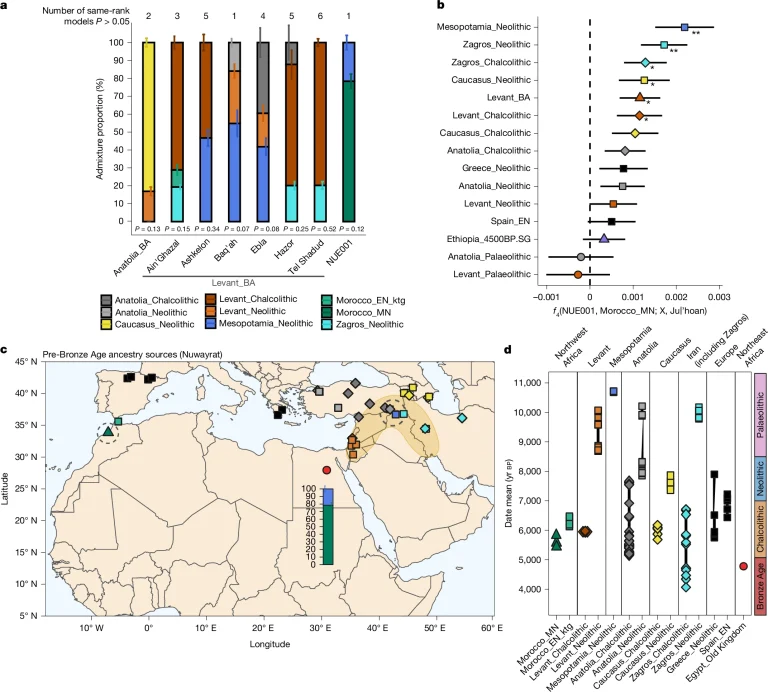Researchers sequence first genome from ancient Egypt, an individual from Nuwayrat
- Researchers have sequenced the first whole ancient Egyptian genome from an individual who lived 4,500 to 4,800 years ago – the oldest DNA sample from Egypt to date.
- 80% of his ancestry was related to ancient people in North Africa and 20% to ancient people in West Asia, providing genetic insights into potential movements of people.
- Marks on his skeleton indicate a lifetime of hard labour, potentially working as a potter or similar.
Researchers from the Francis Crick Institute and Liverpool John Moores University (LJMU) have extracted and sequenced the oldest Egyptian DNA to date from an individual who lived around 4,500 to 4,800 years ago, the age of the first pyramids, in research published today in Nature.1
Forty years after Nobel Prize winner Svante Pääbo’s pioneering attempts to extract ancient DNA from individuals from ancient Egypt, improvements in technology have now paved the way for the breakthrough today, which is also the first whole genome (the entire set of DNA in an individual) from ancient Egypt.2
During this period of ancient Egyptian history, archaeological evidence has suggested trade and cultural connections existed with the Fertile Crescent – an area of West Asia encompassing modern-day Iraq, Iran and Jordan, among other countries.
Researchers believed that objects and imagery, like writing systems or pottery, were exchanged, but genetic evidence has been limited due to warm temperatures preventing DNA preservation.
In this study, the research team extracted DNA from the tooth of an individual buried in Nuwayrat, a village 265km south of Cairo, using this to sequence his genome.

The burial had been donated by the Egyptian Antiquities Service, while under British rule, to the excavation committee set up by John Garstang. It was initially housed at the Liverpool Institute of Archaeology (which later became part of the University of Liverpool) and then transferred to World Museum Liverpool.3
The individual died at some point in the overlap between two periods in Egyptian history, the Early Dynastic and Old Kingdom periods, and had been buried in a ceramic pot in a tomb cut into the hillside. His burial took place before artificial mummification was standard practice, which may have helped to preserve his DNA.
By analysing his genetic code, the researchers showed that most of his ancestry mapped to ancient individuals who lived in North Africa. The remaining 20% of his ancestry could be traced to ancient individuals who lived in the Fertile Crescent, particularly an area called Mesopotamia (roughly modern-day Iraq).
This finding is genetic evidence that people moved into Egypt and mixed with local populations at this time, which was previously only visible in archaeological artefacts. However, the researchers caution that many more individual genome sequences would be needed to fully understand variation in ancestry in Egypt at the time.
By investigating chemical signals in his teeth relating to diet and environment, the researchers showed that the individual had likely grown up in Egypt.
They then used evidence from his skeleton to estimate sex, age, height, and information on ancestry and lifestyle. These signs suggested he could have worked as a potter or in a trade requiring comparable movements, as his bones had muscle markings from sitting for long periods with outstretched limbs.4
Adeline Morez Jacobs, Visiting Research Fellow and former PhD student at Liverpool John Moores University, former postdoctoral researcher at the Crick and first author, said:
“Piecing together all the clues from this individual’s DNA, bones and teeth have allowed us to build a comprehensive picture. We hope that future DNA samples from ancient Egypt can expand on when precisely this movement from West Asia started.”
Linus Girdland Flink, Lecturer in Ancient Biomolecules at the University of Aberdeen, Visiting Researcher at LJMU and co-senior author, said:
“This individual has been on an extraordinary journey. He lived and died during a critical period of change in ancient Egypt, and his skeleton was excavated in 1902 and donated to World Museum Liverpool, where it then survived bombings during the Blitz that destroyed most of the human remains in their collection. We’ve now been able to tell part of the individual’s story, finding that some of his ancestry came from the Fertile Crescent, highlighting mixture between groups at this time.”
Pontus Skoglund, Group Leader of the Ancient Genomics Laboratory at the Crick and co-senior author, said:
“Forty years have passed since the early pioneering attempts to retrieve DNA from mummies without successful sequencing of an ancient Egyptian genome. Ancient Egypt is a place of extraordinary written history and archaeology, but challenging DNA preservation has meant that no genomic record of ancestry in early Egypt has been available for comparison. Building on this past research, new and powerful genetic techniques have allowed us to cross these technical boundaries and rule out contaminating DNA, providing the first genetic evidence for potential movements of people in Egypt at this time.”
Joel Irish, Professor of Anthropology and Archaeology at Liverpool John Moores University and second author, said:
“The markings on the skeleton are clues to the individual’s life and lifestyle – his seat bones are expanded in size, his arms showed evidence of extensive movement back and forth, and there’s substantial arthritis in just the right foot. Though circumstantial these clues point towards pottery, including use of a pottery wheel, which arrived in Egypt around the same time. That said, his higher-class burial is not expected for a potter, who would not normally receive such treatment. Perhaps he was exceptionally skilled or successful to advance his social status.”
In future work, the research team hopes to build a bigger picture of migration and ancestry in collaboration with Egyptian researchers.
Bibliographic information:
Morez Jacobs, A., Irish, J.D., Cooke, A. et al., Whole-genome ancestry of an Old Kingdom Egyptian, Nature (2025), DOI: https://doi.org/10.1038/s41586-025-09195-5



